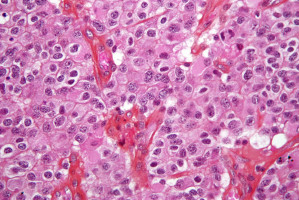
Despite improvements in the past few decades with surgery, chemotherapy and radiation therapy, a predictably curative treatment for glioma does not yet exist.
New insights into specific gene mutations that arise in this often deadly form of brain cancer have pointed to the potential of gene therapy, but it's very difficult to effectively deliver toxic or missing genes to cancer cells in the brain.
Now, Johns Hopkins researchers report they have used nanoparticles to successfully deliver a new therapy to glioma cells in the brains of rats, prolonging their lives.
A draft of the study appeared this week on the website of the journal ACS Nano.
Previous research on mice found that nanoparticles carrying genes can be taken up by brain cancer cells, and the genes can then be turned on.
However, this is the first time these biodegradable nanoparticles have effectively killed brain cancer cells and extended survival in animals.
For their studies, the Johns Hopkins team designed and tested a variety of nanoparticles made from different polymers, or plastics.
When they found a good candidate that could deliver genes to rat brain cancer cells, they filled the nanoparticles with DNA encoding an enzyme, herpes simplex virus type 1 thymidine kinase (HSVtk), which turns a compound with little effect into a potent therapy that kills brain cancer cells.
When combined with the compound, called ganciclovir, these loaded nanoparticles were 100 percent effective at killing glioma cells grown in laboratory dishes.
"We then evaluated the system in rats with glioma and found that by using a method called intracranial convection-enhanced delivery, our nanoparticles could penetrate completely throughout the tumour following a single injection," says Jordan Green, Ph.D, associate professor of biomedical engineering and ophthalmology at Johns Hopkins.
"When combined with systemic administration of ganciclovir, rats with malignant glioma lived significantly longer than rats that did not receive this treatment." (Intracranial convection-enhanced delivery uses a pressure gradient to enhance diffusion throughout the tumour.)
In addition to revealing that biodegradable polymeric nanoparticles represent a promising mode of gene delivery for glioma, the findings show that nonviral DNA delivery of HSVtk combined with administration of ganciclovir has potent antitumor effects.
"To date, this type of system has only been used in humans with viral methods of gene delivery, of which the safety profiles are still heavily in debate," says Betty Tyler, associate professor of neurosurgery at Johns Hopkins.
"Additional studies are needed to see if these nanoparticles could also effectively deliver other antitumour genes for the treatment of brain tumours as well as systemic cancers."
Green also noted that additional safety and efficacy studies are needed before the treatment makes its way to the clinic.
"It also is unknown what the ideal gene combinations are that should be delivered using this nanoparticle delivery system," he says.
"We will move forward by evaluating this technology in additional brain cancer animal models."
In its current form, Green envisions that the nanoparticles would be administered locally in the brain during the surgery that is commonly used to treat glioma.
In the future, these nanoparticles may be able to be administered systemically rather than directly to the brain.
"We are encouraged by these promising results and look forward to optimising the intracranial distribution of this new nanoparticle gene therapy strategy," says Tyler.
Source: Johns Hopkins Medicine
The World Cancer Declaration recognises that to make major reductions in premature deaths, innovative education and training opportunities for healthcare workers in all disciplines of cancer control need to improve significantly.
ecancer plays a critical part in improving access to education for medical professionals.
Every day we help doctors, nurses, patients and their advocates to further their knowledge and improve the quality of care. Please make a donation to support our ongoing work.
Thank you for your support.